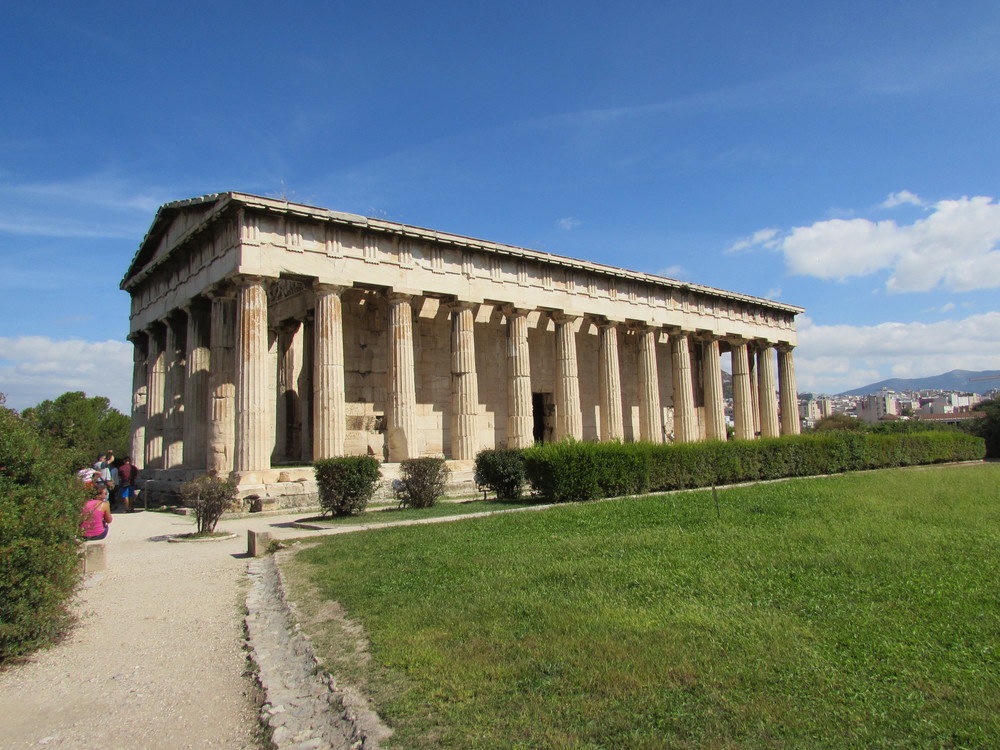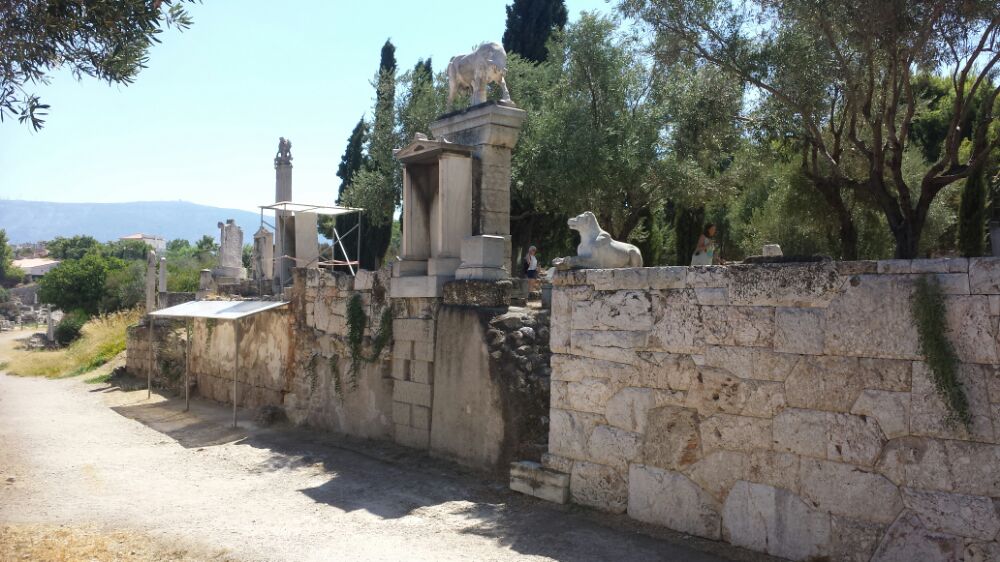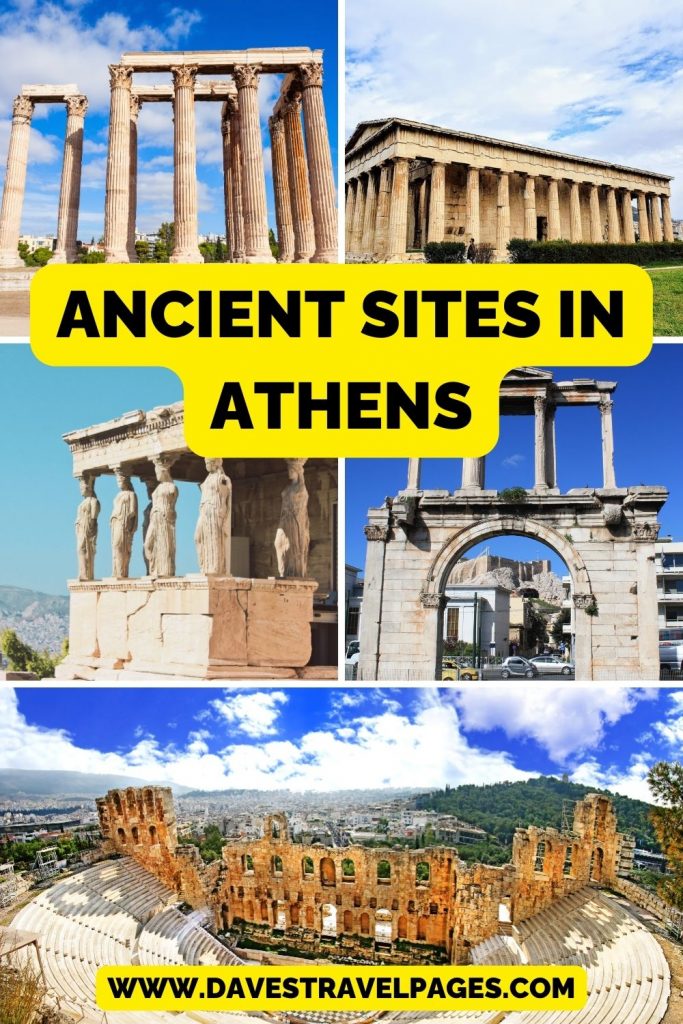In this guide to the must-see historical sites in Athens, you'll discover there's more to Athens than just the Acropolis! Here's the top 10 historical places in Athens that you need to see on your next visit.

Exploring Historic Athens
If you're looking for a city that has rich history, culture, and lots of ancient monuments then Athens is the place for you! Although in modern times the city has sprawled in all directions, there is a clear historic centre that can easily be explored on foot over a couple of days.
Check out my 2 day travel guide to Athens for an itinerary: 2 Days in Athens
Walking through the streets of the historic center, which is basically the area around the Acropolis, you will come across many relics of the past.
Some of the historic sites in Athens date from the ancient Greek and Roman times. Others, like the Byzantine churches in Athens, are “only” a thousand years old!
Historical Sites in Athens Greece
There are dozens of landmarks in Athens, but if you are only visiting the city for just a few days, here's the top ten historical sites in Athens you should consider seeing:
1. The Acropolis of Athens
The Acropolis of Athens is an ancient citadel, located up on a hill. For most people, Athens Greece is synonymous with this supreme monumental complex, and it is the most important of the landmarks of Athens. The fascinating UNESCO World Heritage Site consists of fortification walls, temples and other ancient ruins.

The first constructions on the Acropolis were built during the Mycenaean era, around the 13th century BC. Most of the notable temples and other ruins we can see today were constructed at the time of Pericles, in the 5th century BC.
The Parthenon is the most famous temple in the Acropolis. It was dedicated to Athena, the city’s patron goddess. Visitors can also see the Erechtheion, the temple of Athena Nike and the massive Propylaia gates. The theatre of Dionysus, which hosted many ancient theatrical performances, and the Odeon of Herodes Atticus are on the slopes underneath.
Allow for at least an hour and a half to explore the ancient ruins. You will need enough time to take in the amazing views of the city of Athens. Afterwards, consider a visit to the Acropolis Museum, where many of the artifacts discovered at the Acropolis are now on display.
Related: Guided tours of the Acropolis
2. Temple of Zeus / Olympieion
This massive temple was dedicated to the King of Gods, Zeus. It is one of the largest and most impressive temples in the whole of Greece.

Olympieion was built over several centuries, from the 6th century BC to the 2nd century AD, during Emperor Hadrian’s reign. At the time of completion, it consisted of 104 columns and measured 96×40 metres. Nearby, there were smaller temples and other buildings, as well as a Roman cemetery.
Even though only 15 of the original columns of the Temple of the Olympian Zeus remain today, visitors can still appreciate the magnitude of this amazing Greek monument. As you are walking around the ruins, you will notice the Acropolis hill in the background!
Related: Interesting facts about Athens
3. Hadrian’s Gate / Arch of Hadrian
Right next to the temple of Zeus, you can’t miss the 18-metre tall Hadrian’s Arch. This monumental gate was built out of marble, to honour the Roman Emperor Hadrian.

The fact that it’s located right on a busy avenue in the modern city makes this one of the more interesting monuments of Athens! As you can see from this photo of Vanessa and myself taken in front of the Arch of Hadrian during a bicycle tour in Athens. If you get the angle right, you can get the Acropolis in the frame as well!
Related: Athens Bike Tour
4. Tomb of Filopappos / Philopappus Monument
The monument of Filopappos is a tomb dedicated to a benefactor and prominent Athenian citizen, Filopappos. The majestic construction is on top of Filopappos hill, also known as Muses hill, opposite the Acropolis.
Visitors and locals often come up here to enjoy the green space and take some fresh air. It’s a fantastic point to take in the views of the city of Athens.
5. Socrates’ Prison
Α controversial historic site up on Muses Hill is the so-called Socrates’ Prison. According to urban legend, the ancient Greek philosopher was kept here before he was made to drink the conium, best known as hemlock.
There are at least two locations on Filopappos Hill that were supposed to be Socrates’ prison. In reality, it appears that the exact location of this historic site remains unknown. Still, it is easy to imagine that the Greek philosopher spent some time in one of these ancient caves.
6. The Ancient Agora of Athens
The Ancient Agora of Athens is a wonderful site to visit. It is a large area full of ancient ruins, resembling an open-air museum.
In ancient times, the Agora functioned as a marketplace, and not only. It was the place where everything happened. Commercial activities, political discourse, sports, arts and gatherings, everything happened right here in the Ancient Agora. The name itself, Agora, indicates an assembly or place for gatherings.

The importance of the Ancient Agora gradually faded, and the marketplace was eventually moved on to the Roman Agora. Over the centuries, new constructions were built on top of the ancient site.
Excavations began in the early 20th century, and they are still ongoing. In these years, an enormous amount of ancient ruins has been revealed.
Today, visitors can see the temple of Hephaestus, the best preserved ancient temple in Greece. Many more remains of temples and other buildings have been excavated. In addition, you will see a beautiful Byzantine 10th century church, the Holy Apostles.
Another highlight in the Ancient Agora is the Stoa of Attalos. In ancient times, it was a covered walkway and shopping arcade. Today, it has been transformed into an excellent museum, where you can learn about life in ancient Athens.
A couple of hours is a good amount of time to spend in the Agora and the museum. Unless you are going with a guided tour, try to read some history before you visit.
Related: Visiting the Ancient Agora of Athens
7. Areios Pagos / Areopagus Hill
This iconic historic site in Athens is located opposite the Acropolis, and it’s a fantastic place to take photos from. However, the Areopagus is much more than just a viewing spot.
During the ancient times, Areios Pagos was the city’s court. This was the location where trials for serious crimes, such as murders and arson, took place. The Rock is also famous for Apostle Paul’s sermon in 51 AD.
To get to Areopagus, you will need to use a metal staircase. When you are up there, pay attention to the slippery stones. Find a comfortable rock to sit on, and spend some time admiring the beautiful view. There's no entry fee for Areopagus, so if you are looking for free things to do in Athens, put this on your list!
Related: What is Athens famous for?
8. Kerameikos Cemetery in Athens
The ancient site of Kerameikos was originally the area where potters and other artisans lived. This is where the notable Athenian vases were created. Later on, the site became the cemetery of ancient Athens.

In fact, Kerameikos is split in two parts, which are separated by the Themistoclean Wall. This massive fortification in Athens was originally built in 478 BC, to help defend the city from an imminent Spartan attack. The ancient cemetery was outside the wall, parts of which are visible today.
Findings from Kerameikos cemetery include hundreds of tombs, and many burial-related artefacts. You can see them in the small but very interesting museum in the site. This is one of the more overlooked historical places in Athens, but one to head for if you've already visited the ‘big name' attractions.
Related: Kerameikos Archaeological Site and Museum
9. The Roman Agora of Athens
The Roman Agora of Athens is another historic site in Athens Greece. It was built in the late 1st century BC as the new marketplace in Athens, effectively replacing the Ancient Agora.
The first construction built in the Roman Agora was the Tower of the Winds. This octagonal monument was a groundbreaking invention, used to measure time and to identify the direction of the winds. Its creator was Andronicos, an astronomer who came from a place called Kyrrhos in Macedonia.
The Roman Agora was dominated by the large marketplace, which we could describe as the first mall in history. This became the heart of all commercial activity in Athens. Other notable buildings include the Agoranomion, dedicated to the Roman Emperors, and the public latrines.
During the Byzantine and Ottoman eras, the Roman Agora was gradually covered with houses, workshops and newly built churches. This includes the Fetiye Mosque, which has survived. The Tower of the Winds was converted into a Christian church, and later into the Dervishes tekke.
If you run out of time to visit the Roman Agora, you can still walk around the fence and look at the impressive remains.
10. Hadrian’s Library
The Roman Emperor Hadrian also commissioned this monumental, luxurious library. It was built in 132 AD, and comprised of a library, auditoriums, and tranquil gardens.

Like other historic buildings in Athens, Hadrian’s library was destroyed by the Heruli in 267 AD. It was subsequently covered by debris and other constructions that were built on top. Today, you can see the ruins, just opposite Monastiraki metro station.
FAQ About Historic Places in Athens
Some of the most commonly asked questions about the historical places to see in Athens include:
What should I not miss in Athens?
You certainly can't miss out on visiting the Acropolis and Parthenon in Athens. Other historic places of interest to see in Athens include the Ancient Agora, Temple of Olympian Zeus, and Aeropagus Hill.
What are the ruins in Athens called?
The Acropolis is one of the most iconic sites in Athens. It's located on a hill overlooking the city and has been around for centuries. The ruins are called “Acropolis” as well, but they're not all from the same time period. You'll find temples, statues, and other structures that date back to different time periods – some being more than 2,500 years old!
What were three famous places in Athens?
Athens is a beautiful city full of history and charm. If you are traveling to Athens, there are three famous places that you should not miss out on seeing. The Acropolis, the Temple of Zeus, and the Ancient Agora will surely be an experience worth remembering.
What is Athens famous for?
Athens is perhaps most well known for being the birthplace of democracy, and is often called the cradle of Western Civilization. Ancient Athens was home to philosophers, writers, mathematicians, and doctors – many of whom still influence the way we live our lives today!
More Athens and Greece travel guides
If the Athens landmarks listed above have given you a taste to see more of the city and other places within easy reach, you'll want to read these other guides:
- The Panathenaic Stadium in Athens
- The Best Day Trips from Athens
- Greece Historical Sites
- Where to stay near the Acropolis
- Ancient temples in Greece

 – Dave Briggs
– Dave BriggsDave is a travel writer who's been living in Greece since 2015. In addition to creating this travel guide to historic sites in Athens Greece, he's also written hundreds more travel guides to other Greek attractions and destinations. Follow Dave on social media for travel inspiration from Greece and beyond: